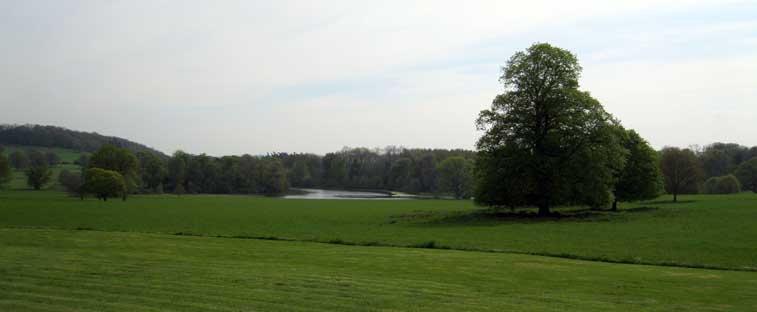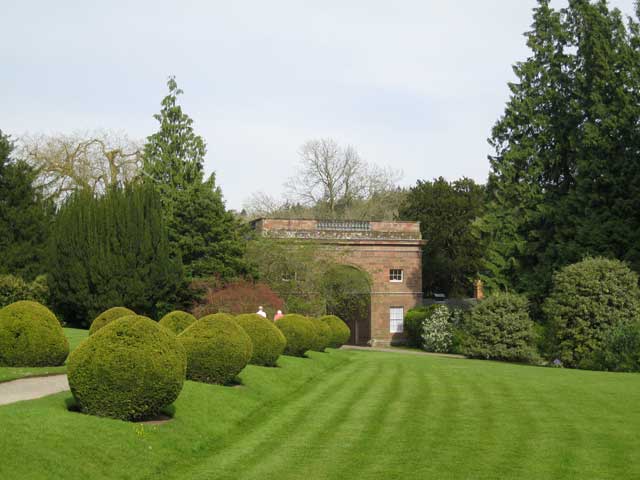

Experts believe that a conversation held at Berrington Hall in Herefordshire was so strongly worded that it impregnated itself in the structure. The tirade of the owner, Edward Harley, and the more measured responses of his architect and place-maker, Lancelot Brown, known as ‘Capability’, have been captured by a new technology, developed by the department of unlikely science at Whatt Hereford University. The technology remains secret, pending patent applications, but we are reliably informed that it involves whelks and a wellington boot. Some parts of the following extracts have required more or less speculative interpretation. These are marked with one, two or, where the speech was indecipherable, three asterisks.
The recording begins with the sound of a door opening:
At this point the conversation moved on to the iniquities of education, particularly its dissemination among garden boys in the northern counties. However, the following gloss has been put on this extract in two posts, which we reprint here by kind permission of The Brown Advisor (http://thebrownadvisor.com/).
300 frequently asked questions about Brown, your queries answered, copyright The Brown Advisor.
In earlier posts, such as notes 31 and 58, the Brown Advisor has endeavoured to separate out variety, greatness and extent, suggesting that these qualities should be held in balance. Islands, as the poet Shenstone remarked, give beauty, if the water be adequate; but lessen grandeur through variety – and surely he borrowed the thought from the great Spectator himself, Joseph Addison, who remarked that ‘there is generally in Nature something more Grand and August, than what we meet with in the Curiosities of Art’. But now I am asked, by Mr. S of Leominster, whether there is really anything grand about Berrington. The question is a difficult one for a Herefordshire man, since that county is the home of the ardent picturesque, and for such people ‘grand’ has a meaning that is close to ‘sublime’, while whatever else Berrington may be, it is emphatically not sublime. But might I put it to Mr. S that Berrington is still grand in Addison’s sense. The lake is not visible from the house, nor is the London Approach brought round the lake as it might be, because the landscape is to unfold piece by piece, almost by accident, with no hint of ‘the Curiosities of Art’. So the north front with its pediment is more decorated than the south simply because the north front needs a little more decoration to give it an even chance against the south, with its splendid view south to the industries of Leominster. Everything about the position of the house is a little skew-whiff because its compositions are to be subordinated to Nature.
As William Combe put it: ‘Where Nature is grand, improve her grandeur, not by adding extraneous decorations, but by removing obstructions. Where a scene is, in itself, lovely, very little is necessary to give it all due advantage, which undergoes no variety of cultivation.’
We should not think the less of Berrington if it continually confounds our expectations that it should behave like other, earlier, of Brown’s landscapes. I fear Mr. S that the fault lies in our own preconceptions of what landscape is.
300 frequently asked questions about Brown, your queries answered, copyright The Brown Advisor.
Mr. S of Leominster has on occasion been mistaken for a badger, but Berrington he has known for what it is for well over 20 years. In his correspondence therefore he goes on to ask how much one should rely on the imagination for an understanding of the place. In many posts, such as notes 29 and 30, I have mentioned the role that the imagination has to play in the appreciation of Brown’s landscape. Never is this role more prominent than at Berrington. I remember that on my first visit a few decades ago I chanced to ask a member of staff where I should go in order to get a good view of the lake. She took me from room to room in an increasing kerfuffle, calling on other staff as she did so, somewhat ruefully to discover that, although she had worked there for many years, she had never noticed that the lake is, to all intents and purposes, invisible from the house. In short, her imagination, and that of the other members of staff, had been played on by Brown, who had so related house and lake as to convince them that they must be intervisible even though they weren’t.
Brown, as it seems to me, once he had learnt to play the imagination in this fashion, was immediately released to make his landscapes more complex: our imaginations tell us that Berrington is simple and coherent, Brown therefore does not trouble to make it simple and coherent. In fact he makes it complex, incoherent and more picturesque than Uvedale Price – but still we are persuaded to take it for granted as harmonious, gentle, easy and smooth. Such is the master-piece that is Berrington. Complex, yes, a Chinese box, yes, but no more complex and no more a Chinese box than a late quartet of Beethoven’s – and no more to be despised as ‘academic’ just because we cannot immediately understand it.
Throughout 2016 John Phibbs is leading a series of Capability Brown masterclasses, to be held at some of his finest landscapes across the country. For further details, please contact Gilly Kitching of Inspiration Events on 0207 370 4646 or at info@inspirationevents.com. Details can also be found at www.johnphibbs.uk.

